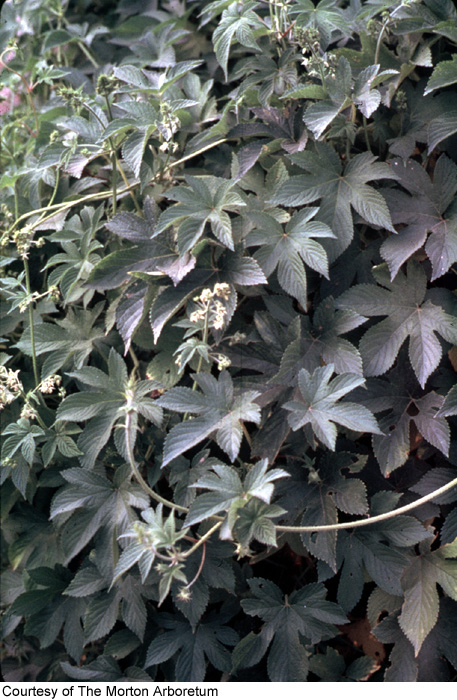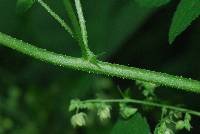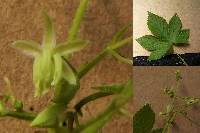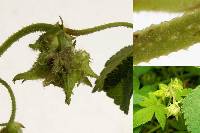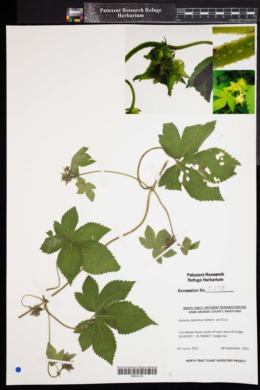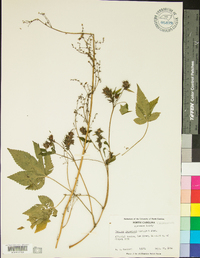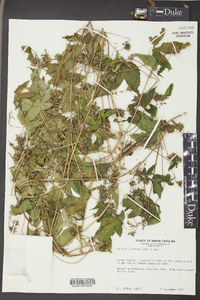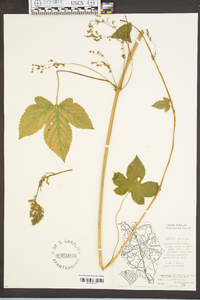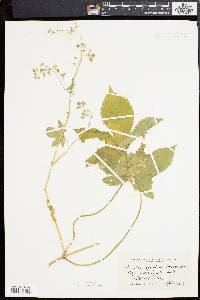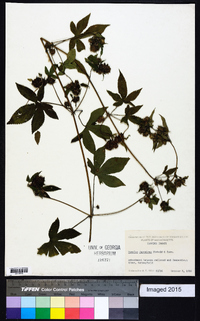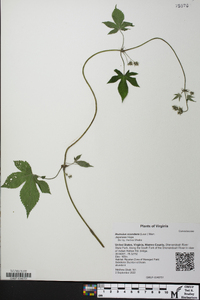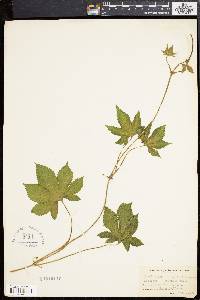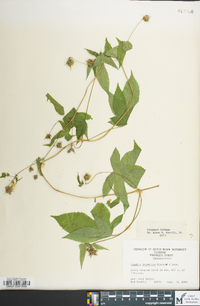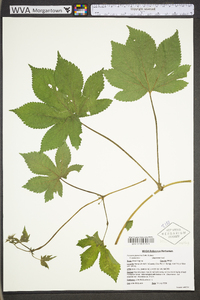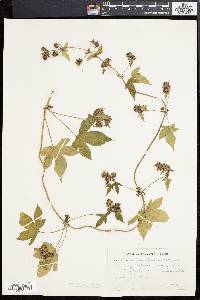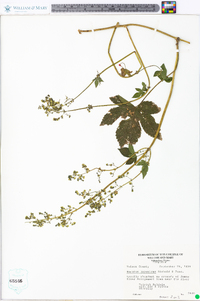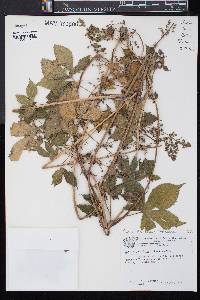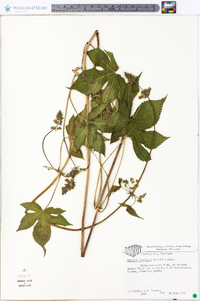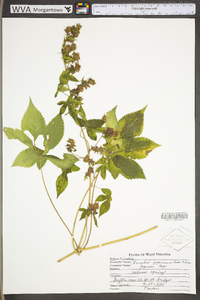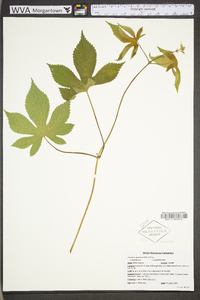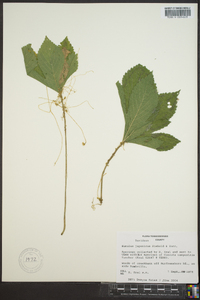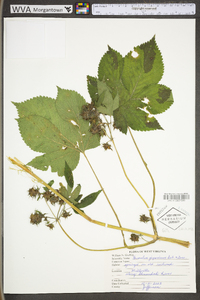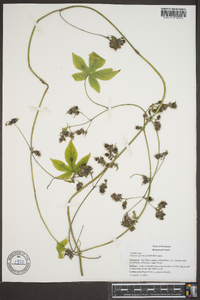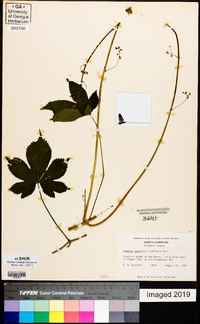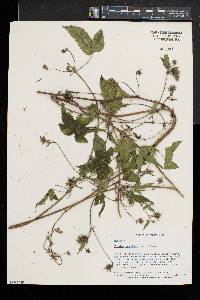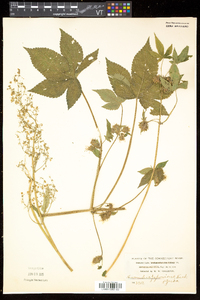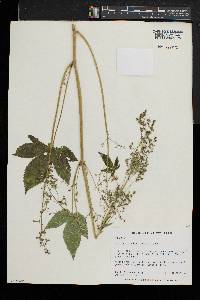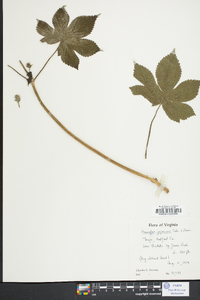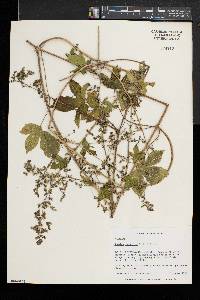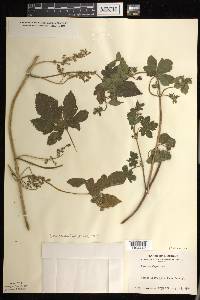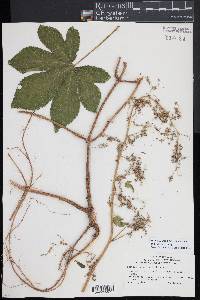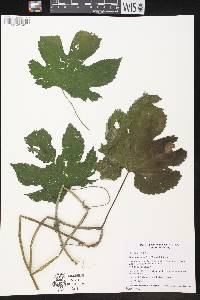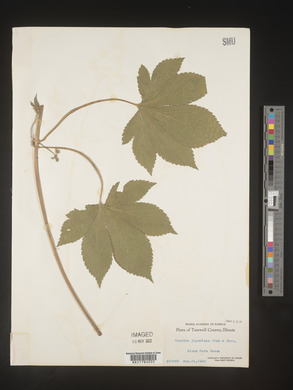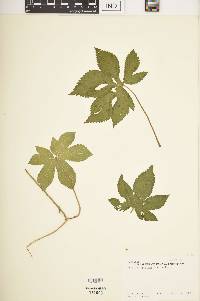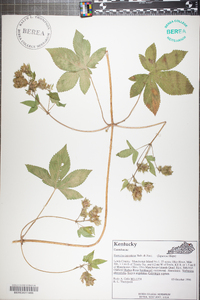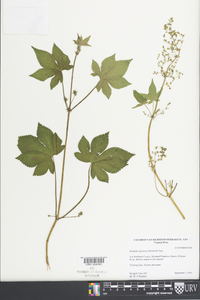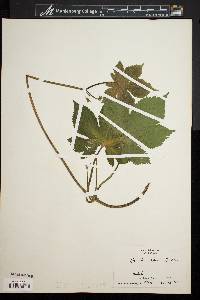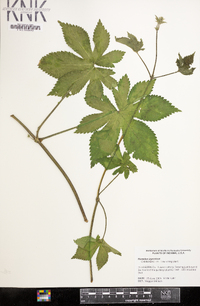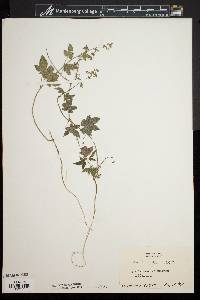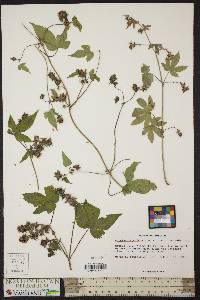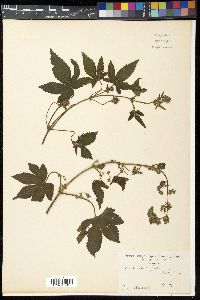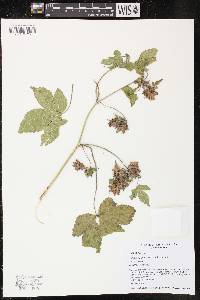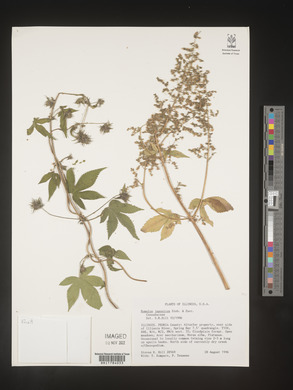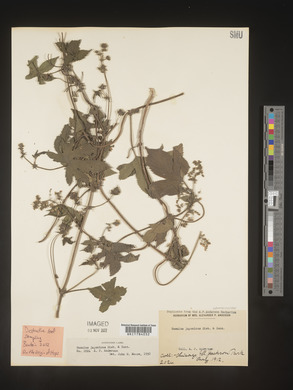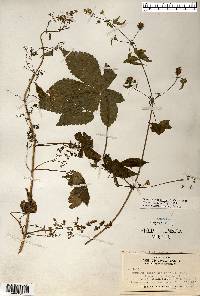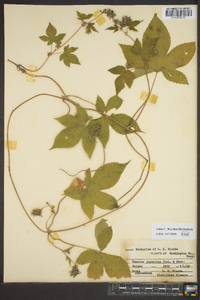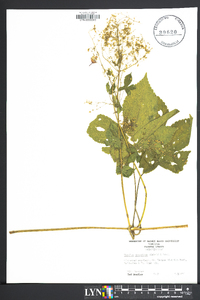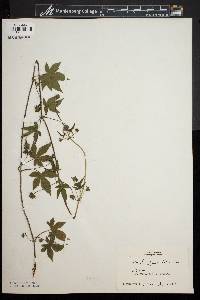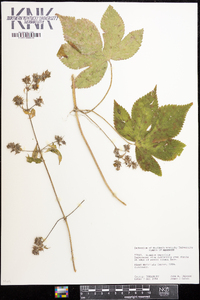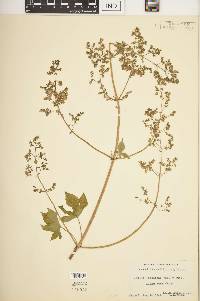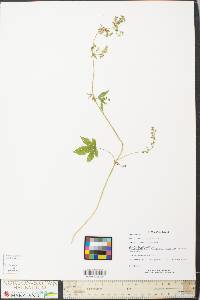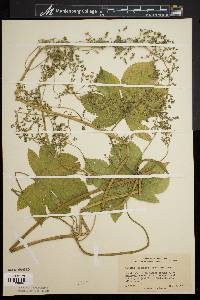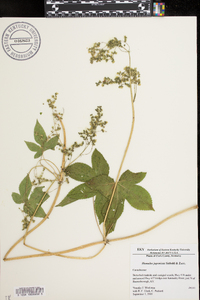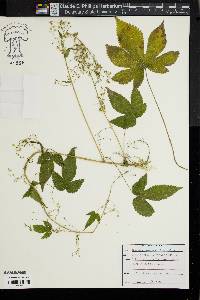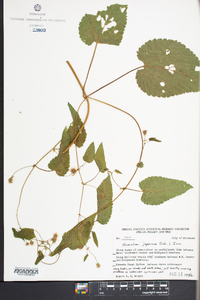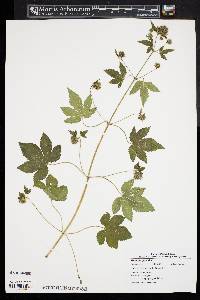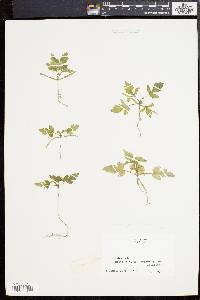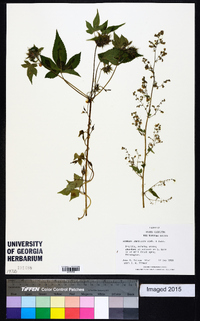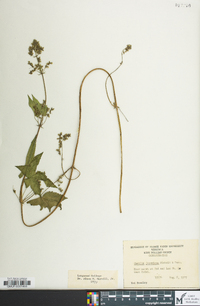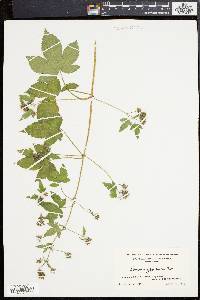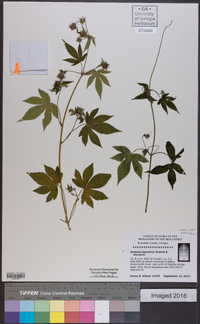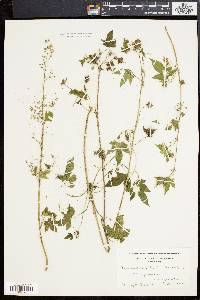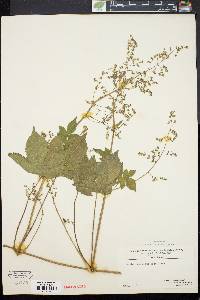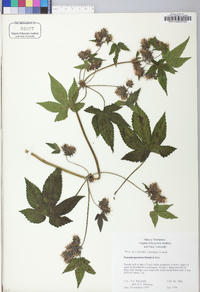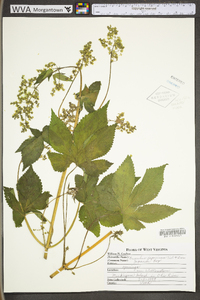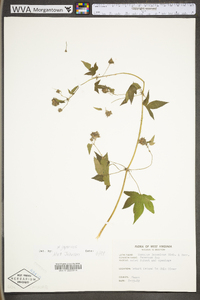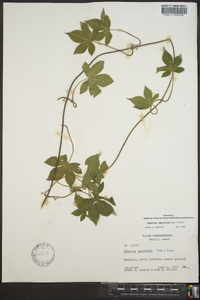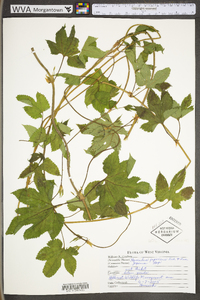
|
|
|
|
Family: Cannabaceae
Japanese Hop
|
Herbs , annual, vining, 0.5-2.5 m. Stems usually branched. Leaves: petioles usually longer than blades. Leaf blade cordate, palmately 5-9-lobed, 5-12 cm, margins of lobes serrulate, apex acuminate; surfaces abaxially with veins pubescent, with stiff hairs, glands yellow, sessile, discoid, adaxially margins of younger leaf blades with stiff cystolithic hairs. Inflorescences: staminate inflorescences erect, 15-25 cm, flower anthers without glands; pistillate inflorescences spikes, conelike, ovoid; bracteole ovate-orbiculate, 7-10 mm, pilose, margins densely ciliate-hairy. Infructescences pendulous, green, conelike, ovoid to oblong, (1-)1.5-3(-4) cm; bracteoles without yellow glands. Achenes yellow-brown, ovoid-orbicular, inflated to lenticular, 4-5 mm, glandless. 2 n = 20, including 6 chromosomes concerned with sex determination. Flowering early-mid summer. Roadsides, fencerows, waste places, riverbanks; 0-1000 m; introduced; Ont., Que.; Ala., Ark., Conn., Del., Ga., Ill., Ind., Iowa, Kans., Ky., Maine, Md., Mass., Mich., Minn., Mo., Nebr., N.J., N.Y., N.C., N.Dak., Ohio, Pa., R.I., S.C., S.Dak., Tenn., Vt., Va., W.Va., Wis.; Asia. Although I have no records from New Hampshire, the state is within the geographic range of Humulus japonicus . Variegated forms of Humulus japonicus , cultivated as ornamentals, are sometimes spontaneous. The vernacular name Japanese hop(s) is occasionally misapplied to H . lupulus var. cordifolius (Miquel) Maximowicz, a variety not found in North America. The disposition of the name Humulus scandens (Loureiro) Merrill, based on Antidesma scandens Loureiro, is problematic. E. D. Merrill (1935) was convinced that the name A . scandens applied to the species Humulus japonicus . If Merrill was correct, then the combination Humulus scandens would have priority. The material described by Loureiro, however, was not preserved, and his description does not coincide with that of H . japonicus . Humulus scandens is not included in synonymy in this treatment. I. A. Grudzinskaya (1988) segregated Humulus japonicus as a new monotypic genus, Humulopsis , with the single species Humulopsis scandens (Loureiro) Grudzinskaya.
Annual herbaceous vine 0.5 - 2.5 m long Stem: twining, usually branched, with rigid, two-branched hairs that help the plant climb. Leaves: opposite, palmately lobed with mainly five to nine lobes (upper ones with three to five), long-stalked, 5 - 12 cm long, heart-shaped with a pointed tip, saw-toothed, stiff-hairy on veins beneath. Flowers: either male or female, borne on separate plants (dioecious), small, without petals. Male flowers small, with five sepals. Stamens five. Female flowers short-stalked, subtended by a leaf-like bract. Ovary covered by the membranous, fused sepals (calyx). Stigmas two, thread-like. Fruit: an achene, enclosed inside the persistent sepals, yellowish brown, 4 - 5 mm long, egg-shaped to orbicular, covered by bracts. Male inflorescence: an axillary and terminal, upright cluster (cymose panicle) of flowers, 15 - 25 cm long. Female inflorescence: a short, axillary spike of two flowers, to 2 cm long, subtended by a leaf-like bract that is densely covered with tiny spines and marginal hairs. Similar species: The similar Humulus lupulus and its varieties differ by having glandular, mostly unlobed or three-lobed leaves. Flowering: mid-August to early October Habitat and ecology: Introduced from Asia. Disturbed, weedy areas. Often becoming weedy itself. Occurence in the Chicago region: non-native Etymology: Humulus comes from the word humus, meaning ground, referring to the trailing habit of this plant. Japonicus means "of or from Japan." Author: The Morton Arboretum Weedy annual vine; stem and lvs much rougher than in no. 1 [Humulus lupulus L.]; petioles commonly longer than the 5-9-lobed blades; uppermost lvs usually 3-5-lobed; mature pistillate spikes to 2 cm, their bracts relatively small, under 1 cm, densely spinulose-ciliate, dull green, conspicuously and abruptly acuminate, scarcely glandular, releasing the ripe achenes; 2n=32 (pistillate), 34 (staminate). Native of e. Asia, escaped from cult. from N. Engl. to N.C. and Mo. July-Oct. Gleason, Henry A. & Cronquist, Arthur J. 1991. Manual of vascular plants of northeastern United States and adjacent Canada. lxxv + 910 pp. ©The New York Botanical Garden. All rights reserved. Used by permission. From Flora of Indiana (1940) by Charles C. Deam Reported from Tippecanoe County by Wilson but probably more frequent than our knowledge of its distribution indicates. I found it along roadsides near Warsaw and Hobart. Found, also, by Chas. M. Ek in Howard County along a railroad. ...... Indiana Coefficient of Conservatism: C = null, non-native Wetland Indicator Status: FACU |

